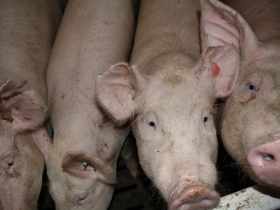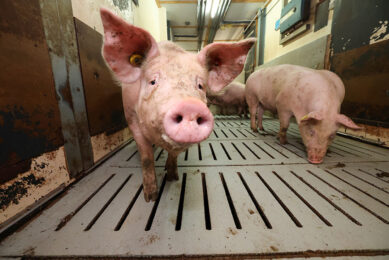Higher air scrubber stacks, less odour nuisance by pig houses

Increasing the stack height of pig-house air scrubbers reduces the odour nuisance to the surroundings: this means of limiting odour levels can offer pig farms an interesting and economical alternative.
Model calculations were carried out to explore the effectiveness of switching odour-reduction plants on or off on the basis of the prevailing wind speed. Using these systems only when required results in low odour levels (of almost the same levels emitted from air scrubbers operated continuously) at considerably lower costs. This has been demonstrated in a study carried out by Wageningen UR Livestock Research which was financed by the Product Board for Livestock and Meat (PVV).
Technical options
The desk study explored technical options for the reduction of odour hindrance from pig houses. The researchers compared the following technical options for the reduction of odour levels: air scrubbers, increasing the stack height, diluting pig-house air exhausted from air scrubbers and a series-connected emission-reduction technique.
They used an odour distribution model to calculate odour levels attained with the continuous operation of the various technical options. Air scrubbers with an increased stack height (15 metres above the ground) offered the best price-quality ratio.
Effectiveness of temporary measures
Model calculations were also carried out to explore the effectiveness of switching odour-reduction plants on at low wind speeds and off at higher wind speeds. This can offer a solution in the most extreme odour-nuisance situations, such as sultry evenings.
Operating an air scrubber solely when air speeds were lower than 3 metres per second achieved almost the same odour level obtained with an air scrubber that is operated continuously, while the operating hours were almost halved and the costs (in particular, electricity) were substantially lower. Switching on more expensive technical measures solely to reduce peak odour levels is appealing to pig farmers and their surroundings.
Sustainability is enhanced
Odour nuisance is a critical factor in the pig-farming sector. The new Odour Nuisance and Livestock Farming Act came into force on 1 January 2007. Many pig farms using the available odour-reduction systems which wish to expand their operations find themselves confronted with the limits imposed by this Act..©
Implementing new or existing technical measures for the reduction of odour nuisance can enable pig farms to expand their operations within the scope offered for the odour nuisance to their surroundings. Implementing cost-effective measures will enhance the sustainability of pig-farming operations.
Related websites:
• Wageningen University and Research Centre©(WUR)©©
• Dutch Product Board for Livestock and Meat











